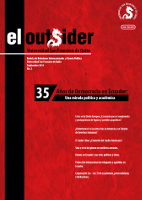Las mujeres van a la guerra
Contenido principal del artículo
Resumen
Este artículo explora el debate académico que existe en torno al rol que cumple el género en los conflictos armados. Históricamente se ha creído que las mujeres tienen un papel secundario en la práctica de la violencia en conflictos internos, centrándolas como víctimas y no como victimarías. Se ha pretendido sustentar estas afirmaciones con estudios psicológicos y prejuicios de género. Por este motivo, el enfoque que este artículo propone hace referencia también a estudios psicológicos pero además toma estudios acerca de conflictos armados internos en los que las mujeres han tenido protagonismo. Pretende sustentar que las mujeres son igual de violentas que los hombres. Este argumento se apoya en la ya demostrada participación activa de las mujeres como efectivos militares en enfrentamientos bélicos acaecidos en conflictos post Guerra Fría y en los diferentes tipos de violencia que ellas perpetran. Como estudio de caso se tomará al conflicto en Siria.
Detalles del artículo
Citas
Alison, M. (2004). Women as agents of political violence: Gendering Security. Security Dialogue, 447-463.
Austin, H., & Cheikhomar, A. (23 de Junio de 2013). They can't succeed without us': Women take front-line role in Syria conflict. Recuperado el 2014, de NBC News: http://worldnews.nbcnews.com/_news/2013/06/23/19076204-they-cant-succeed-without-us-women-take-íront-line-role-in-syria-conflict?lite
Baron, R., & Richardson, D. (1994). Human Agression. New York: Plenum Press.
Becraft, C. (19 de Enero de 2005). Facts About Women in the Military, 1980-1990. Recuperado el 18 de Febrero de 2014, de Feminism and Women's Studies: http://feminism.eserver.org/workplace/professions/women-in-the-military.txt
Bloom, M. (2011). Bombshell: The Many Faces of Women Terrorists. Toronto: Penguin.
Brownmiller, S. (1975). Against Our Will: Men, Women and Rape. New York: Simon and Schuster.
Bystydzienski, J. (1993). Women in Groups and Organizations: Implications for the Use of Force. En R. H. Howes, & M. R. Stevenson, Women and the use ofmilitary force. Boulder: Lynne Rienner.
Candil, A. (30 de Noviembre de 2007). ¿Deben las mujeres ir a la guerra? Recuperado el 10 de Marzo de 2014, de Grupo de Estudios Estratégicos: http://www.gees.org/articulos/deben_ir_las_mujeres_a_la_guerra_4776
Caprioly, M., & Boyer, M. (2001). Gender, Violence, and International Crisis. Journal of Conflict Resolution, 503-518.
Carpenter, C. (2003). "˜Women and Children First"™: Gender, Norms, and Humanitarian Evacuation in the Balkans. International Organization, 661-694.
Churchil, L. B. (2005). Exploring women "™s complex relationship with political violence: A study of the weathermen, radical feminism and the new left. Florida: University of South Florida Press.
Derisas, F. (29 de Septiembre de 2012). Entre XXy XY...la diferencia es más que una letra. Recuperado el 10 de Marzo de 2014, de Tendencias: http://diario.latercera.com/2012/09/29/01/contenido/tendencias/26-119330-9-entre-xx-y-xy-la-diferencia-es-mas-que-una-letra.shtml
Diehl, J. (28 de Octubre de 2012). A jihadist group prospers in Syria. Recuperado el 19 de Febrero de 2014, de The Washington Post: http://www.washingtonpost.com/opinions/jackson-diehl-a-jiha- dist-group-prospers-in-syria/2012/10/28/c036128a-1ed8-11e2-ba31-3083ca97c314_story.html
Elgot, J. (26 de Julio de 2013). Syria's Female Rebels: The Islamist Aleppo Brigade Fighting Assad's Forces. Recuperado el 19 de Febrero de 2014, de The Hiffington Post: http://www.huffingtonpost.co.uk/2013/07/26/syria-female-fighters_n_3658205.html
Esman, A. (14 de Febrero de 2014). Who are the women fighting in Syria? Recuperado el 19 de Febrero de 2014, de Breitbar: http:// www.breitbart.com/Big-Peace/2014/02/14/Who-Are-The-Women-Fighting-In-Syria
Gerard, D. (2008). Wanted: Afew Good Women. New York: UNIFEM.
German, L. (2008). Women and the War ofTerror. Feminist Review, 140-149.
Goldstein, J. (2001). War and Gender: How Gender Shapes the War System and Vice Versa. Cambridge: Cambridge University Press.
Jervis, R. (1988). War and Misperception. Journal of Interdisciplinary History, 675-700.
Kolko, G. (1994). Century of War. New York: The New Press.
Lee Ray, J. (2001). Integrating Levels of Analysis in World Politics. Journal of Theoretical Politics, 355-388.
Levy, J. (2008). Counterfactuals and Case Studies. En Oxford University, The Oxford Handbook of Political Methodology (págs. 627-644). Oxford: Oxford University Press.
Man, T. S. (1954). Man, The State and War. New York: Columbia University Press.
Mearsheimer, J. (1994). The false promise of international institutions. Cambridge: Harvard University.
OMS. (2014). Género. Recuperado el 2014 de 19 de Febrero, de Organización Mundial de la Salud: http://www.who.int/topics/gender/es/
Sarkees, M., & Wayman, F. (2010). Resort to War: 1816 - 2007. CQ Press, 1-32.
Schneider, C., & Wagemann, C. (2012). Set-Theoretic Methods for the Social Science. A guide to Qualitative Comparative Analysis. New York: Cambridge University Press.
Searcy, S. (1982). The incidence of female criminilaty in the contemporary worldbyFredaAdler. Contemporary Sociology, 675.
Sjoberg, L. (2010). Women fighters and the "beautiful soul" narrative. International Review of the Red Cross, 53-68.
Syrian Report. (20 de Abril de 2013). Lionesses of National Defence. Recuperado de Syria Report: http://www.syriareport.net/lionesses-of-national-defence/
Varela, N. (2005). Feminismo para principiantes. Barcelona: Ediciones B.
Waltz, K. (1979). Theory of International Politics. New York: Random House.
Zalles, J. (2004). Dominio, sumisión y dependencia. En Z. J, Barreras al diálogo y al consenso (págs. 54-77; 165-172). Quito: Norma.
Zwerman, G. (1997). Participation in undergound organizations: Conservative and feminism images of women associated with armed, clandestine organizations in the United States. London: JAI Press.

